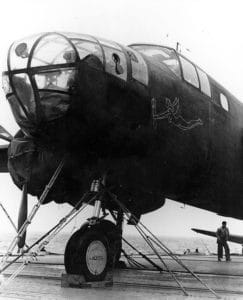In the spring of 1942, 80 men volunteered to fly a mission to lands unknown while at Columbia Army Air Base.
The old Columbia Army Air Base was the breeding ground for a secret mission in early 1942, a mission that would ultimately change of course of world history. Just over a month after the United States entered the WWII, US Army engineer and pilot Lt. Colonel Jimmy Doolittle and co-pilot Richard E. Cole prepared to lead one of the most daring episodes of WWII.

Doolittle B-25B on board the USS Hornet April 1942.
The U.S. had suffered a series of defeats in Guam, Corregidor, Wake Island, and Bataan, and including the Philippine Death March in early combat. These defeats demoralized Americans and the US military were desperate for a victory. That victory boost came on April 18, 1942, when they launched sixteen B-25 Mitchell bombers from the USS Hornet in the Pacific ocean in a secret retaliatory attack on Japan following the surprise bombing of Pearl Harbor in December 1941. There were 80 men involved in the raid and each knew it could be a suicide mission, but took the risk anyway to defend America and avenge the 2,335 deaths at Pearl Harbor. The Raider mission was the subject of the book “Four Came Home” and the movie “Thirty Seconds Over Tokyo.”
Before the Doolittle Raiders lifted off the Hornet they were spotted by the Japanese sooner than they had anticipated and launched their mission 200 miles further out to sea than expected. This early launch placed the men in jeopardy of exhausting their fuel before making it to China following their raid. Navigator of Plane number 8, Nolan Herndon of Edgefield, SC, who passed away in 2007, calculated that they didn’t have enough fuel to make their after mission destination. The other planes reached China by what many believe was a Providentially provided almost 30mph tailwind. Herndon, said in an interview in 2002, that the crew was praying and he was “reciting the 23rd Psalm.”
Each plane successfully hit military and industrial targets in Tokyo and other cities in Japan. Short on fuel the crews were forced to bail out and abandon their aircraft or crash land their planes. All planes were lost. Plane 8 landed in Russia and were interned there for 13 months. Of the 80 men who began the mission, three were killed after bailing out: Leland D. Faktor, Corporal. He was buried by Rev. John M. Birch after whom the John Birch Society was later named. Two men from Crew #6 drowned as a result of crash landing in the water off the China coast: Sergeants Donald E. FitzWorld history was changed at Columbia Army Air Base maurice and William J. Dieter. Eight of the Raiders were captured by the Japanese: Dean Hallmark, Bob Meder, Chase Nielsen, Bill Farrow, Robert Hite, George Barr, Harold Spatz, and Jacob DeShazer. Three of these men were executed by firing squad: Hallmark, Farrow, and Spatz. Meder, died of beri-beri and malnutrition while in prison. Four were kept 40 months in prison, most of which was in solitary confinement. The balance of the Raiders made it to safety.
Doolittle initially thought his mission had been a failure due to losing all of his planes and causing minimal damage to the Japanese military complex. But, unknown to Doolittle the raid was highly successful by striking at the heart of the Japanese empire. The raid greatly boosted the morale of the American people and military following the depression that had set in after the December attacks and other military defeats. The raid caused the Japanese military to call back men and material from offensive positions to defend their island. That reorganization of the Japanese defenses created an American military advantage in the following months at the Battles of Midway, Coral Sea, and the Solomon Islands.
Doolittle received the Medal of Honor for leading the Raid on Tokyo. Each of the other 79 Raiders received the Distinguished Flying Cross for their part in the mission. The Doolittle Raiders were among the most recognized veterans coming out of WWII.
Sixty two of the Raiders survived the WWII. Doolittle died in 1993. Doolittle’s co-pilot, the last surviving Raider, Richard E. Cole died April 9th at 103 years old.
Beginning in 1946 the surviving members gathered each April 18th to commemorate the raid and their lost comrades. In the 1950s the Raiders were presented a set of 80 silver goblets inscribed with the name of each Raider. Each year they held a toast to each Raider member who had passed on the preceding year, turning that member’s inscribed goblet upside down. The final meeting of the survivors of the Doolittle Raiders came on the weekend of Veterans Day 2013 in hopes that each Raider had completed their final mission.
Cole is the last witness to what seemed an impossible mission of the Doolittle Raiders. That mission changed the course of the war, reinvigorated the American morale and defined a generation of Americans who became known as “the greatest generation.”
Michael Reed is managing editor of The Standard.




 RSS - Posts
RSS - Posts